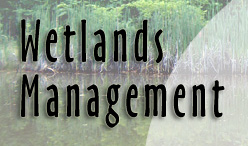Reptiles (snakes and
turtles) and amphibians (frogs, toads, and
salamanders) are collectively known as herpetofauna
or herps. Numerous amphibians and reptiles
depend on wetland during all or a portion of their
life cycles. It doesn’t matter where you live—
almost everyone has had an opportunity to hear the
calls of frogs and toads streaming from a wetland—it
is one of the first signs of spring.
Amphibians
As a young boy growing up on a dairy farm in
Wisconsin, I fondly recall going down to our old
oxbow wetland in the pasture after a warm spring
rain and collecting hundreds of American toads. Just
the day before there was no toads calling. The toads
were trilling loudly and embraced in amplexus (the
mating hug where the smaller male rides on the back
of the larger female). I carried several 5-gallon
buckets of toads up to the cow’s water trough by the
barn until the trough was covered with toads and the
wetland was silent once more. During the night it
rained heavily and by morning there was not a toad
left in the trough but the wetland was once again
alive with the trill of toads. Unfortunately, even
though the wetland remains today—it is now silent
once again. Amphibians have suffered a world-wide
decline due to a number of factors including water
pollution, chemicals, ultraviolet radiation, and
wetland loss.
Many amphibians use wetlands for reproduction. Most
of the 90 species of frogs and toads in the U.S. use
wetlands and a number of salamanders also use
wetlands extensively. The best wetlands for most
amphibians have good quality water, an even mixture
of open-water and emergent vegetation, and are
shallowly and seasonally flooded to prevent the
establishment of fish. Wetlands that do not harbor
fish often have more amphibian species than wetlands
that contain fish. Many species of amphibians such
as chorus frogs, spadefoot toads, wood frogs, and
spotted salamanders need wetlands without fish in
order for their eggs and tadpoles to live long
enough to turn into juveniles capable of leaving the
wetland.
Amphibians consume algae, plants, and invertebrates
produced within wetlands. Wetland amphibians also
eat invertebrates that occur near the wetland but
are actually upland species. Some of these
invertebrates are crop pest species—thus amphibians
are valuable natural insect controllers.
Do you want to learn more about amphibians? Click on
the following links to learn more about selected amphibian
species.

See a
Northern Leopard Frog.
See
Spring Peepers.
back to top
Reptiles
A number of reptiles also use wetlands. Some of the
most well known reptiles include turtles, such as
common snapping turtles or painted turtles, and
alligators. However, a number of other species
including snakes also depend on wetlands for their
survival. Populations of turtles can be quite high
in some deepwater wetlands. Densities of over 25
common snapping turtles per acre have been commonly reported.
Turtles, like clean water with an abundance of prey
species such as fish or amphibians, deep undercut
banks and pools for hibernating, and for basking
turtles such as painted turtles, woody debris for
sunning.
Alligators depend on wetlands but they also help to
deepen and change the topography within wetlands.
Alligators form deep “gator holes” to create a more
permanent source of water in areas where wetlands
can dry out. This deep hole provides habitat for a
number of fish, shellfish, turtles, and
invertebrates such as grass shrimp that need longer
periods of water. The material that alligators rake
out with their feet and move to the side of their
hole, builds up areas creating more diversity in the
water levels which influences plant species
composition and distribution and increases the
overall plant and animal diversity.
Reptiles are indeed fascinating creatures of
wetlands. Click on the following species to learn
more about them.
As shown above,
amphibians and reptiles depend heavily on wetlands.
Many amphibians in particular depend on ephemerally
flooded wetlands. To find out what you can do to
help maintain and improve frog and toad populations
as well as some reptiles, read the
guide from the
Partners in Amphibian and Reptile Conservation on
ephemeral wetlands for information on management and
creation of ephemerally flooded wetlands for
amphibians and reptiles. To find out what you can do
for reptiles and amphibians that use more permanent
wetlands read the
guide from the Partners in
Amphibian and Reptile Conservation on permanent
wetlands.
 |

